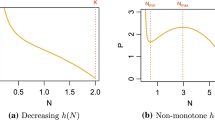Abstract
The Gurtin and Levine model5 is studied in this paper under the assumption that the fecundity of prey depends on age as well as on the total population sizes of prey and predators. The purpose of this study is to see the effect of this density dependence on the stability criteria for the equilibria of the model equations. It is shown that there are cases when, due to density dependence, the model which is originally neutrally stable becomes stable.
Similar content being viewed by others
References
Cushing, J. M.: Integro-differential equations and delay models in population dynamics. In: Lecture Notes in Biomathematics, Vol. 20, Berlin-Heidelberg-New York: Springer 1977
Cushing, J. M.: Stability and maturation periods in age structured pop. In: Differential Equations and Applications in Ecology, Epidemics and Population Problems, Busenberg, S., Cooke, K., (eds). New York: Academic Press, 1981
Cushing, J. M., Saleem, M.: A Predator-prey model with age-structure. J. Math. Biol. 14, 231–250 (1982)
Gopalsamy, K.: Time lags and density dependence in age-dependent two species competition. Bul. Aust. Math. Soc. 25, 271–291 (1982)
Gurtin, M. E., Levine, D. S.: On predator-prey interactions with predation dependent on age of prey. Math. Biosci. 47, 207–219 (1979)
Gurtin, M. E., Levine, D. S.: On populations that cannibalize their young. SIAM J. Appl. Math. 42, 1 (1982)
Gurtin, M. E., MacCamy, R. C.: Non-linear age dependent population dynamics. Arch. Rat. Mech. 3, 281–300 (1974)
Gurtin, M. E., MacCamy, R. C.: Population dynamics with age-dependence. In: Nonlinear Analysis and Mechanics, Heriot-Watt Symposium, Vol. 13, pp. 1–35, Knops, R. J. (ed.) London: Pitman, 1979
Gurtin, M. E., MacCamy, R. C.: Some simple models for non-linear age-dependent population dynamics. Math. Biosci. 43, 199–211 (1979)
Levine, D. S.: Bifurcating periodic solutions for a class of age-structured predator-prey systems. Bull. Math. Biol. 45, 901–915 (1983)
Levine, D. S.: On the stability of a predator-prey system with egg eating predators. Math. Biosci. 56, 27–46 (1981)
Saleem, M.: Predator-prey relationships: Egg-eating predators. Math. Biosci. 65, 187–197 (1983)
Saleem, M.: Egg-Eating Age-structured Predators in Interaction with Age-Structured Prey. Math. Biosci. 70, 91–104 (1984)
Thompson, R. W., DiBiasio, D., Mendis, C.: Predator-prey interactions: Egg-eating predators. Math. Biosci. 60, 109–120 (1982)
Author information
Authors and Affiliations
Rights and permissions
About this article
Cite this article
Saleem, M. Predator-prey relationships: Indiscriminate predation. J. Math. Biology 21, 25–34 (1984). https://doi.org/10.1007/BF00275220
Revised:
Issue Date:
DOI: https://doi.org/10.1007/BF00275220




